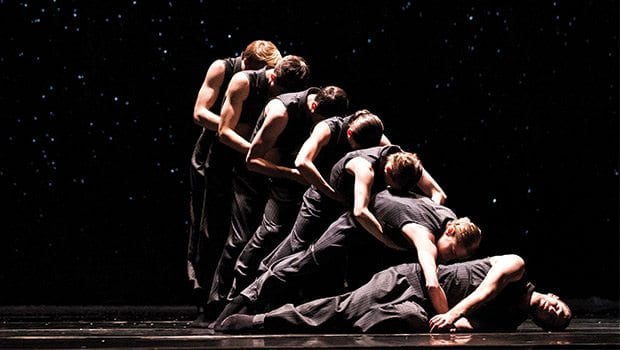Poetry in motion
Hubbard Street Dance Chicago performs at Citi Shubert Theatre

Hubbard Street Dance Chicago came to town last weekend, back for the first time since 2009, to perform three shows at Citi Shubert Theatre. Presented by the Celebrity Series of Boston, the company, now in its 38th season, takes on adventurous works by living choreographers. Its program featured four works new to the company in 2015.
Among its 18 dancers were two graduates of Walnut Hill School for the Arts in Natick, Bolton native Jesse Bechard and Emilie Leriche of Santa Fe.
Opening the two-hour program was “Out of Keeping,” a five-part work for 10 dancers choreographed for the company by a former member, Penny Saunders. As an introduction to the company, the piece demonstrated elements that characterized the entire program: vigorous, athletic movement with strong, angular ensemble formations; and liquid lighting that silhouetted dancers’ muscles and immersed them in chiaroscuro interplays of darkness and light. Dramas without plots, the works engaged the dancers in shape-shifting movements that expressed physical daring, emotion and connection.

Author: Photo: Todd RosenbergHubbard Street Dance Chicago dancers in “Out of Keeping” by Penny Saunders.
Wearing matching body suits in varied colors for the Saunders work, the dancers whirled to the floor and then sprang up as if buoyed by unseen hands. With energy and balletic grace, they turned natural, everyday movements into poetry as they walked, ran, pushed and pulled, tangled and untangled their bodies in solos and with each other.
The score combined music by four contemporary composers with an 18th century piano sonata by Domenico Scarlatti. An interval of silence intensified the intimacy of a duet by Kellie Epperheimer and Jeffery Duffy. As the five women danced alongside one another in unison, their linear formation suggested a row of pulsing piano keys. Compelling but repetitive, “Out of Keeping” seemed long, and the two short works that followed the intermission offered a welcome change of pace.
Attired in matching grey gym wear, two women and two men performed the gender-neutral choreography of the riveting “N.N.N.N.,” by William Forsythe,
who also designed its taut staging. He created the 2002 work for Ballet Frankfurt, and restaged it last year with Hubbard Street for its U.S. premier. To rhythmic bursts of semi-industrial noise in the Thom Willems score, the dancers enacted “a mind in four parts,” wrestling, wrapping, knotting, tangling and unscrambling themselves until they coalesced into a tentative whole.
Both poignant and funny, “A Picture of You Falling” was choreographed by Crystal Pite, who first performed it herself in 2008 at Canada’s National Arts Centre in Ottawa. She also scripted its droll voiceover, in which Kate Strong pronounces in a clipped British voice a series of staccato sentences that evoke the wounds of a painful relationship: “This is a picture of you, falling. Knees, hip, hands, elbows, head. This is how you collapse. This is the sound of your heart hitting the floor.”
The voiceover alternates with the crunching mechanical sounds of Owen Belton’s spare, percussive score. Lighting by Alan Brodie highlighted only a rough black floor and the dancer, who performed on an otherwise dark stage. Jason Hortin made each joint of his body talk. Stepping into the spotlight, he cut a natty figure; but then, to the sound of a shot, he twisted, shuddered and collapsed, only to spring up and compose himself. Again and again he crumbled and rose, each time increasingly disheveled once he was back on his feet. Finally, he turned his back and walked away.
The company concluded its program with a masterpiece, Pite’s “Solo Echo.” Inspired by a Mark Strand poem, “Lines for Winter,” printed in the program, the work reflects on the end of life and the transition from knowing “the tune your bones play” to feeling “that final flowing of cold through your limbs.” Pite created the piece for seven dancers for Nederlands Dans Theater, which premiered it in 2012. Its score combines two Brahms sonatas for cello and piano performed by Yo-Yo Ma and Emanuel Ax.
On a dark stage, lighting by Tom Visser created a constellation evoking snow or stars and illuminated the sculpted arms of the dancers. Their costumes, designed by Pite with Joke Visser, consisted of grey, unisex sleeveless tops and pants. Angular ensemble formations and solos conjured compassion, struggle, anguish and release with fluidity and grace. The sole false note was the melodramatic moment when a dancer opened his mouth in horror like the figure in Expressionist painter Edvard Munch’s iconic portrait of angst, “The Scream.” What lingers is the visceral power of the dancers and the visual drama of their final scene, as, like a stack of cards, their layered bodies united into an arc.






